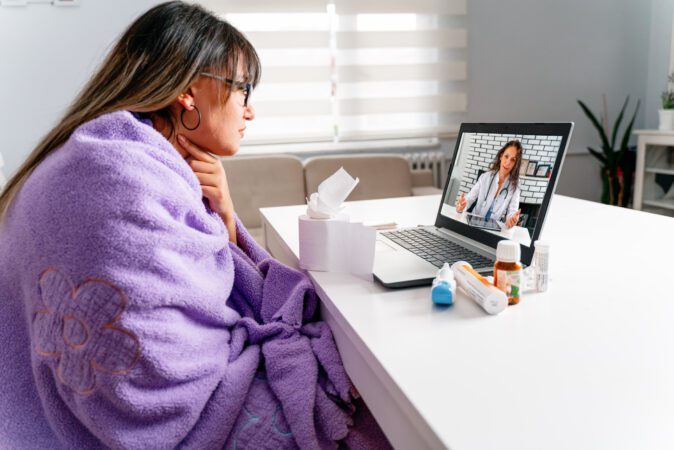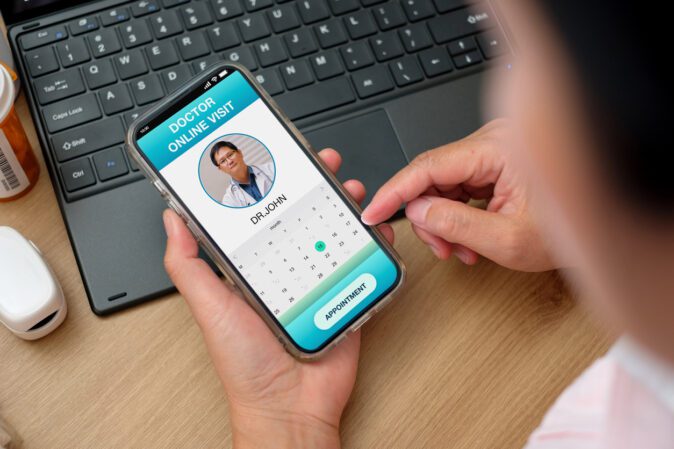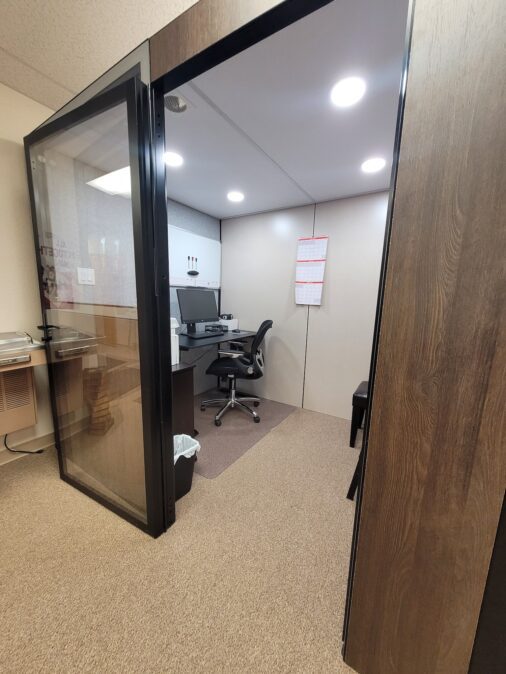
Idaho has a major healthcare workforce shortage, a problem that is exacerbated in rural areas in our vast state.
Increasing the capacity and access to healthcare in the state requires outside-the-box thinking, such as creating spaces for telehealth visits in public libraries.
Telehealth — sometimes called telemedicine — lets a healthcare provider care for a person without an in-person office visit. Telehealth is done primarily online with internet access on a computer, tablet, or smartphone.

Idaho soon will have more libraries offering telehealth services than any other state.
HOW THIS HAPPENED
In 2020, the Blue Cross of Idaho Foundation for Health (the Foundation) partnered with the Idaho Commission for Libraries (ICfL) to pilot a telehealth program in two libraries in rural Clearwater County.
The Foundation’s grant to ICfL provided funding for equipment that included desktop computers, laptops, wifi hot spots, office furniture and supplies, blood pressure machines, digital thermometers, scales, oxygen sensors, and more.
“We started small to test the concept and see if it was feasible,” ICfL Partnerships and Program Supervisor Amelia Valasek said of the initial grant.
Why libraries? Most communities have a library, and they are resource-filled spaces that offer community programs and services. They also possess infrastructure that not all community members have. Technology can be a barrier because unreliable cellphone or internet in remote areas hinders connectivity. Some Idahoans may not own a smartphone or a computer with a webcam, limiting telehealth options. Libraries can fill in those gaps, plus offer a private space.
Libraries have the capacity to establish, maintain and schedule its private, digitally enabled space. Staff can serve as a digital navigator and provide onsite support for technology.
“Our community is still very technologically challenged with limited cell phone service and limited Internet service,” Terri Summerfield, director, Clearwater Country Free Library District, wrote in a grant report.
Libraries also offer resources to supplement telehealth appointments, such as health screenings and classes, and collections of health information materials.
There are external factors, such as transportation issues and distance, fuel costs, and long wait times to get an in-person appointment, that make accessing healthcare more difficult. Telehealth can help people overcome those barriers.
“Libraries offer so much to communities that it makes them an ideal place for Idahoans to access necessary healthcare through telehealth,” Blue Cross of Idaho Foundation for Health Executive Director Kendra Witt-Doyle said. “Increasing access to healthcare is one of our priorities, and the telehealth in libraries grants are one way we can help Idahoans do that.”
EXPANSION HAPPENS
ICfL noted the first-year pilot showed enough promise to warrant an expansion. Dubbed the Telehealth Trailblazers Grant that also was funded by the Foundation, libraries in Caldwell, Challis, Hailey and Parma received funding to offer telehealth.

The opportunity was ideal for Parma, which had recently seen the only health clinic in the city close. Challis, which didn’t have a dedicated space to offer services, acquired a pod that ensures privacy. Hailey reworked a larger, under-used space into two smaller rooms that offer flexibility and privacy. A Caldwell library is piloting a mobile telehealth model.
Meanwhile, the Idaho Department of Health and Welfare (IDHW) was working through its process to support telehealth in the state. The organization is using $500,000 in funding it received through the American Rescue Plan Act (ARPA) to allow libraries to upgrade their space. In late 2022, 13 libraries were selected for the program:
- Ada Community Library (Victory branch)
- Ammon
- Boise (Downtown branch)
- Culdesac
- Idaho Falls
- Jerome
- Kamiah
- Lapwai
- Mountain Home
- New Meadows
- Payette
- Salmon
- Winchester
That upped the number of Idaho libraries offering telehealth to 19.
“That’s huge – no other state has more libraries doing this,” said Rachael Masaitis, a Human Services Program Specialist at IDHW. “This will increase access to medical providers, behavioral health and counseling.”
IDHW still has additional funding, and another round of expansion is expected in 2023 that will increase the number of libraries offering telehealth.

THE CHALLENGES
One common issue regarding telehealth for libraries is logistics. Connecting patients, providers and libraries is a new concept and one that takes time. The Foundation supported ICfL with a grant to promote the program through outreach kits, printed materials and social media video campaigns.
“Libraries aren’t walk-in clinics, and there is still work to be done to help libraries, providers and community members understand the role of libraries in telehealth,” Valasek said. “We want to empower librarians to get in touch with local providers and let them know this is happening. We will continue to look for ways to build the capacity of libraries to offer telehealth and other programs and resources that increase the health and well-being of Idahoans.”
Meanwhile, IDHW has contracted with the University of Washington medical school to create a guide for how telehealth in libraries can work. There also are training materials developed on several topics by the Northwest Telehealth Center that librarians can access.
Patients also can initiate telehealth by asking their providers about virtual care options.
“As our community becomes more aware of the individual benefits and they request more physician participation, we are confident that the need for telehealth will continue to grow,” Summerfield wrote in a grant report. “The concept of telehealth is confusing to a lot, especially the elderly. If the providers promote it and encourage it, it could be a very successful program.”
The ICfL is actively seeking the participation and partnership of healthcare providers, especially primary care and family medicine providers. To learn more, visit libraries.idaho.gov/telehealth.